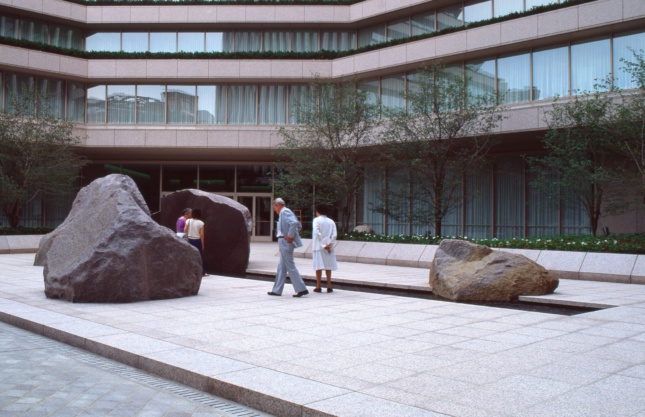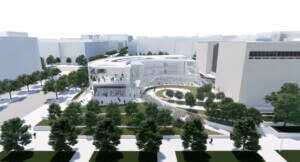In 1984, the scientific and educational organization, the National Geographic Society commissioned Elyn Zimmerman—a then up-and-coming New York-based artist—to produce a sculpture within the modernist plaza of its Washington, D.C., headquarters. Zimmerman designed a long, narrow reflecting pool set among five granite boulders and later named it MARABAR, a reference to the mysterious Marabar Caves at the center of E.M. Forster’s A Passage to India (1924). In The Meaning of Gardens: Idea, Place, and Action (1990), the landscape architect Peter Walker wrote that MARABAR used few materials to elevate “a setting of a rather ordinary building, garden, and stones.”
The sculpture, which has marked the entrance to the organization for over 35 years, was threatened with demolition last July when National Geographic filed plans to “unify the existing National Geographic campus with a new pavilion, plaza, renovated ground level, and cohesive streetscape” with a landscape redesign provided by local architecture firm Hickok Cole. Zimmerman’s sculpture, and any trace of it ever having existed, is absent from the renderings of the organization’s renewed public presence.

Following the District of Columbia’s Historic Preservation Review Board’s approval of the streetscape redesign, the proposed removal of MARABAR caught the attention of The Cultural Landscape Foundation (TCLF), a nonprofit group established to educate and engage the public on the importance of landscape design. “National Geographic is one of the world’s leading champions of cultural awareness,” said Charles A. Birnbaum, TCLF’s president and CEO, in a press statement, “so its plan to demolish a significant work of art under its stewardship is especially disconcerting. Sadly, this is part of a trend in which cultural institutions ironically prove to be a threat to designed landscapes and landscape features in their collections.”
Earlier today, TCLF named the sculptural installation a Landslide site, the group’s designation for landscape features that are at risk of demolition, and has argued that its removal will mark the erasure of the first large-scale stone project in the artist’s repertoire. Given that the project is now pending review by the District of Columbia’s Department of Consumer and Regulatory Affairs, TCLF remains hopeful that “Zimmerman’s sculpture will be reviewed thoroughly and that plans for the new pavilion will be altered accordingly.”
As the plaza MARABAR sits in and other late 20th-century landscape designs reach the half-century mark, the importance of preserving modernist landmarks has increasingly come into focus. Lawrence Halprin’s brutalist Freeway Park in Seattle was recently approved for renovation, while Ricardo Legorreta’s abstracted Pershing Square design in Los Angeles is also slated for demolition.











